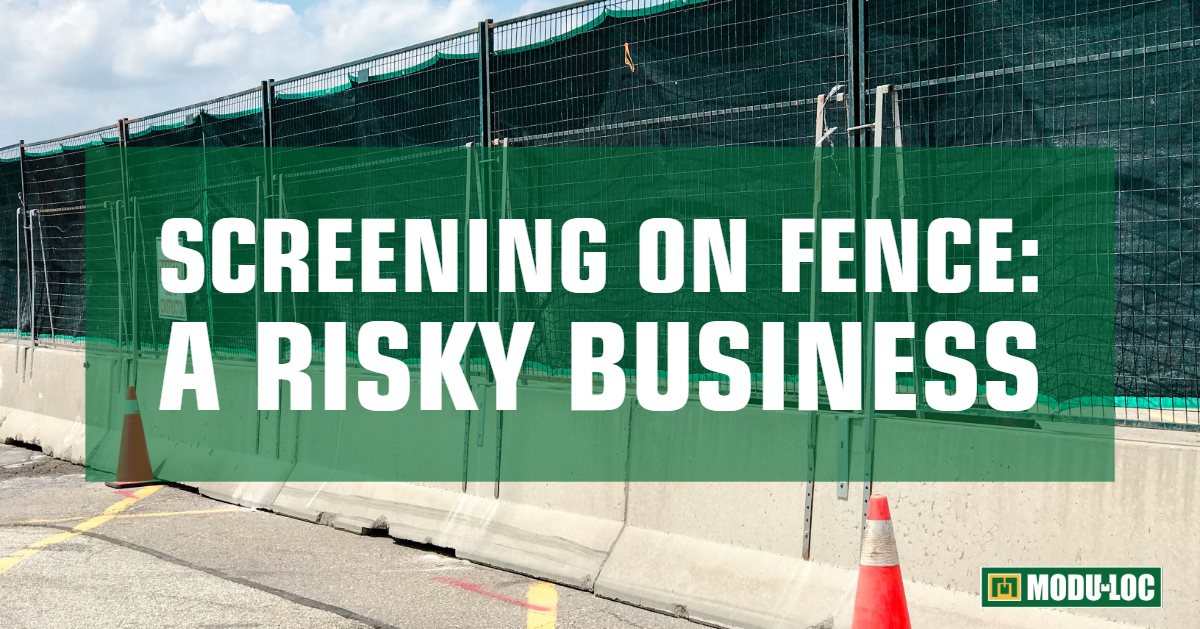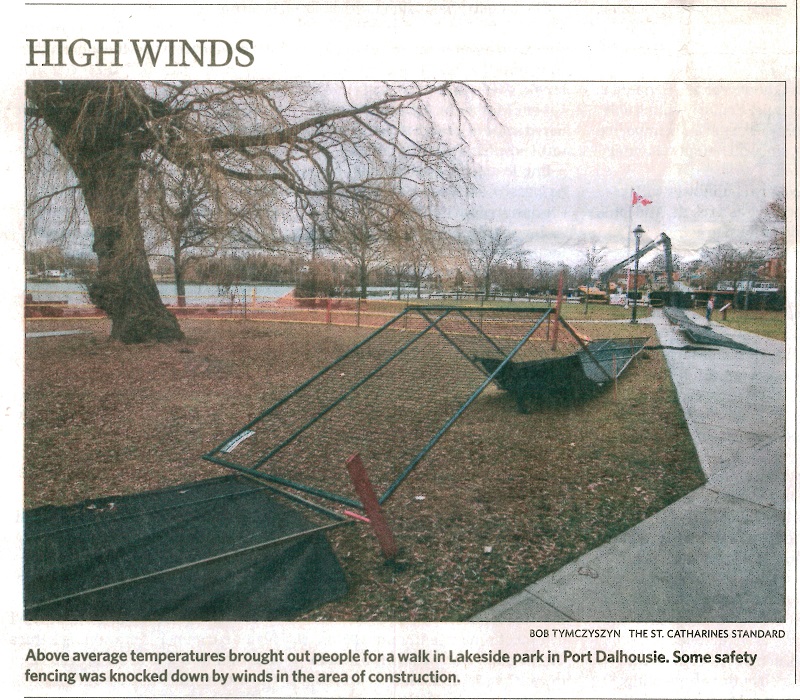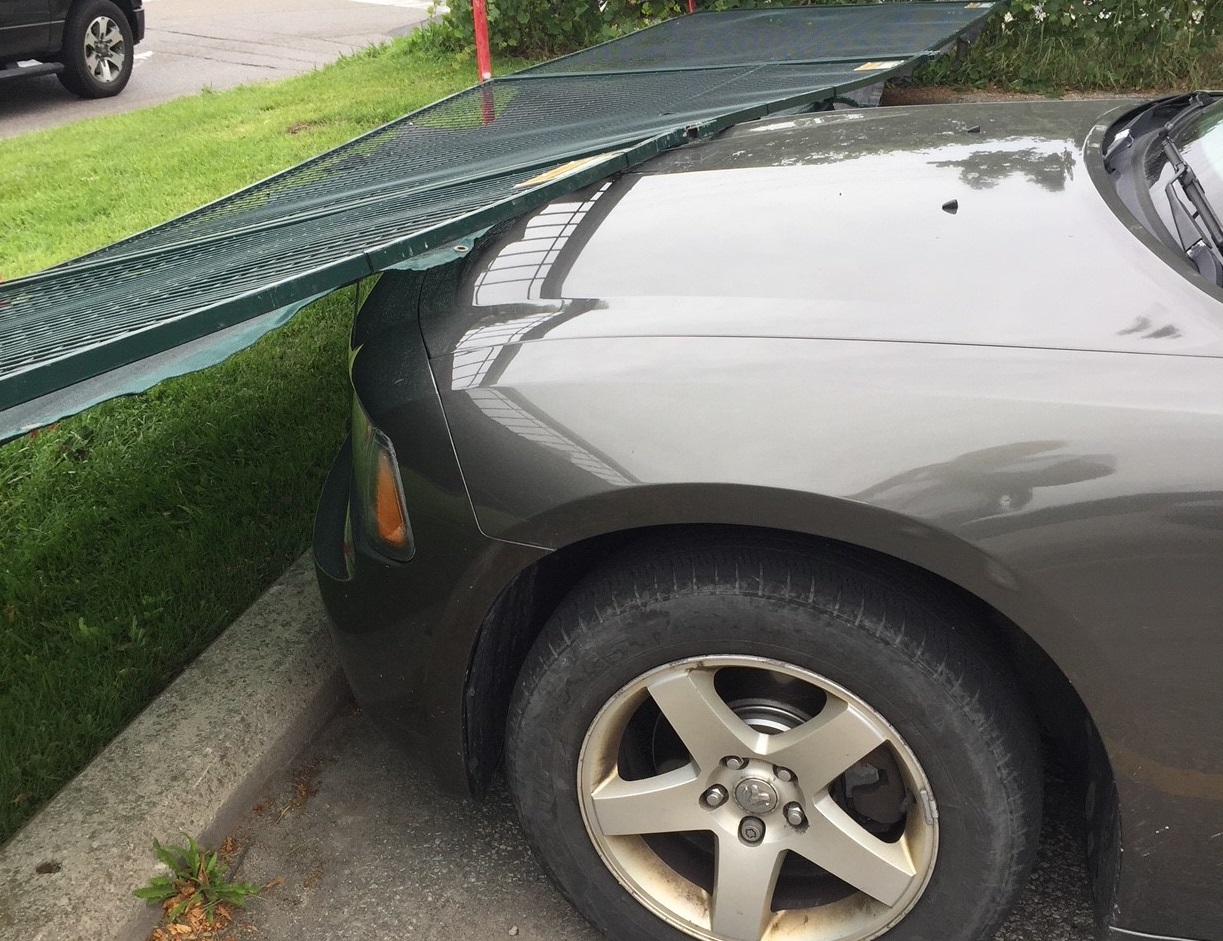Screening on Fence: A Risky Business
January 4, 2019
Recently, we introduced a screening acknowledgement form – and it is causing quite a stir. This particular form asks our customers to acknowledge that the addition of any material to temporary fencing can create structural instability and dangerous conditions. Customers who proceed with hanging banners, signage or hoarding from their temporary fence will be taking responsibility for any resulting risk to public safety.
While this may seem like a bold move, it is a necessary one. In this post, we will break things down and explain why we have introduced this new policy. We hope this will address the concerns our customers may have about the form. More importantly, we hope this will encourage our customers to think differently about something that is currently a very common – and potentially dangerous – practice.
Screening on Fence: A Risky Business
Hanging anything – banners, screening, or signage – from temporary fence increases wind load and negatively impacts stability. Simply, screening prevents wind from blowing through the fence, increasing the risk of fence being blown over. Essentially, when you combine screening with temporary fence, what you get is a giant sail.
Using perforated mesh or adding “wind slits” to your banners isn’t always enough. The fact is that even naked fence panels can be blown over if winds are strong enough. Any surface area added via screening will just increase the likelihood of this happening.

The only true solution is to counteract the effects of the screening by adding stability accessories. There are a number of ways you can improve the stability of your temporary fence system. If you’re planning to hang banners or scrim, reinforce your temporary fence with spikes, triangle bracing, or concrete blocks. Failing to do this could have catastrophic results.
At best, fallen fence is a nuisance. You either need to allocate labour to pick up the fence or call in your supplier to fix the problem, resulting in added costs and time delays. But at worst, your rented fence could damage property or hurt someone.
We’ve seen falling construction fence injure members of the public. There was one case of another supplier’s fence falling onto a vehicle so that the driver was actually trapped in her car. Modu-Loc hasn’t been immune to this problem, either. The above news clipping depicts a site where the customer added their own screening to the fence after install.

Another site (pictured above) had temporary perimeter fencing installed with scrim. On a particularly windy day, the fence blew over and damaged a nearby car. Thankfully, nobody was hurt. Had the fence toppled in the other direction, it could have ended up in live traffic and potentially caused a much worse situation.
Safety & Accountability
In early 2018, we formally added “Safety & Accountability” to our core values. Though we had been focused on safety for some time, it was important to us to emphasize how far we’d come since our inception. This evolution is probably not uncommon in the construction industry. As a whole, the industry has grown tremendously when it comes to the introduction, awareness, and promotion of safe practices and related regulations.
Adding “Safety & Accountability” to Modu-Loc’s core values was a way to make our commitment official. Such a public proclamation helps ensure that we remain accountable for the safety of our employees, our customers, and the general public. It goes without saying that truly committing to safety has a profound impact on how you look at your business. It forces you to alter your perception of what might have been “the norm”.
This is why we introduced the screening acknowledgement form. Safety has to start with us. Mahatma Gandhi once said, “Be the change that you wish to see in the world”. Modu-Loc can no longer encourage a practice that does not align with our values, though it may be widespread within the industry.
Our New Policy
Going forward, Modu-Loc will not supply, drop, rent, sell or install screening or other items on our fence unless the customer acknowledges the inherent risks. As the experts in temporary fence, it is our responsibility to educate our customers about the potential hazards, and teach them about possible solutions. Asking our customers to sign an acknowledgement form simply forces all of us to take a minute and consider the possible dangers associated with hanging screening from any temporary structure.
Of course, it isn’t always easy to challenge the status quo. In fact, doing the right thing may be downright hard at first. We may encounter customers who do not agree with our approach. This will even be an adjustment for our sales team and our field employees, who are used to doing whatever it takes to make our customers happy.
We may lose jobs because of this acknowledgement form. Clients may opt to use another supplier who is willing to look the other way and continue to do what they have always done, without questioning whether it is the right thing to do. As long as we have made those customers aware of the inherent dangers, we have taken an important first step.
Will We Still Install Screening on Fence?
Rest assured, the screening acknowledgement form does not mean that we will refuse jobs which involve screening. We will continue to offer fence screen products and install them on our temporary fence panels. However, we will always advocate for the use of stability solutions when anything is being hung from the fence. We will have the necessary discussions with our customers to ensure that they understand the risks and have been advised accordingly. A signed form simply means that our customers are acknowledging the role they play in maintaining the safety of the public by considering any potential hazards.
Creating Change
In other posts, we’ve discussed how Canada’s construction industry standards often lag behind those in other countries. The good news is we believe that change can start from the bottom. It doesn’t have to be driven by the policy makers; it can be influenced by the industry stakeholders, like contractors, suppliers, and even the public.
So although this acknowledgement form might make us unpopular, we are prepared to have those tough conversations in order to raise awareness. Our hope is that, in the near future, it will be considered unacceptable to hang anything from temporary fence without proper stability solutions in place.
It may take time for the industry to follow suit. But as Nelson Mandela said, “Education is the most powerful weapon which you can use to change the world”. With a little bit of patience and a commitment to educating our customers, we can reduce the frequency of falling fence – one site at a time.
We’re here to answer any questions you may have.



 Canada - EN
Canada - EN Canada - FR
Canada - FR United States
United States




